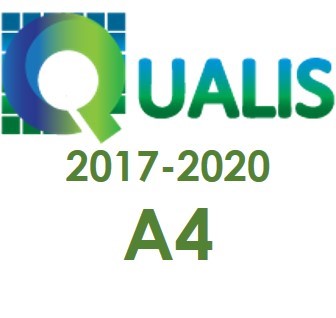Application focused on nonlinear analysis of trusses using Python with programming in the Excel spreadsheet
Keywords:
Python. Excel. Finite elements. Nonlinear analysis. TrussesAbstract
The objective of this work is to present a computational tool for nonlinear analysis of trusses, integrating the Python language and the Excel program. The research hypothesis is based on the possibility of developing a tool that would allow the visualization and analysis of structures with geometrical nonlinear behavior. The methodology is based on the positional formulation of the Finite Element Method, which allows the visualization of the initial and deformed structures after reading the structural data contained in the same Python script spreadsheet. Thus, data entry and analysis become faster and simpler. Four numerical examples of structures with nonlinear behavior are presented, allowing us to conclude that the methodology used is capable of achieving the objectives.
Downloads
References
AGUIAR, A. R.; FOSDICK, R. L. A singular problem in incompressible nonlinear elastostatics. Mathematical Models and Methods in Applied Sciences, Toh Tuck Link, v. 10, n. 8, p. 1181-1207, 2000.
BARBOSA, G. B.; FERNANDES, W. L.; GRECO, M.; PEIXOTO, D. H. P. Numerical modeling of lyapunov exponents for structural damage identification. Buildings, Basel, v. 13, n. 7, p. 1802, 2023.
BOMFIM, D. S.; MARTHA, L. F.; PACCOLA, R. R. An educational computational program for nonlinear geometric analysis of truss structures using the Finite Element Method based on Positions. In: XLV IBERO-LATIN AMERICAN CONGRESS ON COMPUTATIONAL METHODS, 2024, Alagoas. CILAMCE. 2024. Disponível em: < https://www.researchgate.net/profile/Danilo-Bomfim-3/publication/387069426_An_educational_computational_program_for_nonlinear_geometric_analysis_of_truss_structures_using_the_Finite_Element_Method_based_on_Positions/links/675ed661e9427c77e914d56f/An-educational-computational-program-for-nonlinear-geometric-analysis-of-truss-structures-using-the-Finite-Element-Method-based-on-Positions.pdf>. Acesso em: 19 mar. 2025.
BONET, J.; WOOD, R. D.; MAHANEY, J.; Heywood, P. Finite element analysis of air supported membrane structures. Computer Methods in Applied Mechanics and Engineering, Amsterdam, v. 190, n. 5, p. 579-595, 2000.
BRUHN, E. F. Analysis and design of flight vehicles structures. Cincinnati, Tri-State Offset Company, 1973.
CARRAZEDO, R.; CODA, H. B. Alternative positional FEM applied to thermomechanical impact of truss structures. Finite Elements in Analysis and Design, Amsterdam, v. 46, n. 11, p. 1008-1016, 2010.
CODA, H. B. An exact FEM geometric non-linear analysis of frames based on position description. In: XVIII BRAZILIAN CONGRESS OF MECHANICAL ENGINEERING, 2003, São Paulo. COBEM. 2003. Disponível em: <https://repositorio.usp.br/item/001372218>. Acesso em: 23 nov. 2024.
CODA, H. B. O método dos elementos finitos posicional: sólidos e estruturas – não linearidade geométrica e dinâmica. EESC/USP, São Carlos, 2018.
DRIEMEIER, L.; PROENCA, S. P. B.; ALVES, M. A contribution to the numerical nonlinear analysis of three-dimensional truss systems considering large strains, damage and plasticity. Communications in Nonlinear Science and Numerical Simulation, Amsterdam, v. 10, n. 5, p. 515-535, 2005.
FELIPE, T. R. C.; LEONEL, E. D.; HAACH, V.G.; BECK, A. T. A comprehensive ductile damage model for 3D truss structures. International Journal of Non-Linear Mechanics, Amsterdam, v. 112, p. 13-24, 2019.
FORDE, B. W. R.; STIEMER, S. F. Improved arc-length orthogonality methods for nonlinear finite element analysis. Computers & Structures, Amsterdam, v. 27, n. 5, p. 625–630, 1987.
GRECO, M.; PEIXOTO, D. H. N. Comparative assessments of strain measures for nonlinear analysis of truss structures at large deformations. Engineering Computations, Leeds, v. 39, n. 5, p. 1621-1641, 2021.
GRECO, M.; FERREIRA, I. P. Logarithmic strain measure applied to the nonlinear positional formulation for space truss analysis. Finite Elements in Analysis and Design, Amsterdam, v.45, p. 632-639, 2009.
GRECO, M.; GESUALDO, F. A. R.; VENTURINI, W. S.; CODA, H. B. Nonlinear positional formulation for space truss analysis. Finite Elements in Analysis and Design, Amsterdam, v. 42, n. 12, p. 1079-1086, 2006.
HASANÇEBI, O.; TEKE, T.; PEKCAN, O. A bat-inspired algorithm for structural optimization. Computers & Structures, Amsterdam, v. 128, p. 77–90, 2013.
MACHADO, G. A.; GRECO, M.; BECHO, J. S. Ferramenta computacional voltada ao ensino de análise não linear geométrica de estruturas treliçadas. In: 52° COBENGE - CONGRESSO BRASILEIRO DE EDUCAÇÃO EM ENGENHARIA, 2024, Vitória. Anais do COBENGE 2024. COBENGE. 2024. Associação Brasileira de Educação em Engenharia (ABENGE), 2024. v. 1. p. 1-13. Disponível em: <http://dx.doi.org/10.37702/2175-957X.COBENGE.2024.4933>. Acesso em: 23 nov. 2024.
MACHADO, G.A. Ferramenta computacional voltada ao ensino de análise não linear geométrica de estruturas treliçadas. Disponível em: <https://youtu.be/p2E8WYFuoJk>. Acesso em: 23 de nov. 2024.
MACHADO, G. A. Desenvolvimento de software livre para análise de treliças não lineares: Python Positional Truss 3D. Iniciação científica (Graduação em Engenharia Aeroespacial). Universidade Federal de Minas Gerais, Belo Horizonte, 2023.
MICROSOFT CORPORATION. Introdução ao Python no Excel. Disponível em: <https://support.microsoft.com/pt-br/office/introdu%C3%A7%C3%A3o-ao-python-no-excel-55643c2e-ff56-4168-b1ce-9428c8308545>. Acesso em: 22 nov. 2024.
NIU, M. C. Airframe stress analysis and sizing. 2.ed. Califórnia, Hong Kong Conmilit Press, 1999.
OLIVEIRA, R. L. Elaboração de algoritmo com formulação não linear geométrica para cálculo de treliças tridimensionais. Trabalho de Conclusão de Curso (Graduação em Engenharia Civil). Universidade Tecnológica Federal do Paraná, Campo Mourão, 2015.
PEIXOTO, D. H. N. Estudo sobre diferentes medidas de deformação e apresentação da família senohiperbólica generalizada, com aplicação na modelagem de polímeros, biomateriais e tecidos biológicos moles. Tese (Doutorado em Engenharia de Estruturas). Universidade Federal de Minas Gerais, Belo Horizonte, 2024.
PERÔNICA, D. S. Análise não linear de treliças considerando modelos hiperelásticos pelo método dos elementos finitos posicional. 2022. Dissertação (Mestrado em Engenharia Civil). Universidade Federal do Rio Grande do Norte, Natal, 2022.
PYTHON SOFTWARE FOUNDATION. Integrated Development and Learning Environment (IDLE). Disponível em: <https://docs.python.org/3/library/idle.html>. Acesso em: 23 nov. 2024.
QURBANI, M. Python simulation of heating and cooling of extruded tubes using Excel as interface. 2024. Degree Project in Technology (PhD Thesis) - KTH Royal Institute of Technology, Stockholm, 2024. Disponível em: <https://www.researchgate.net/publication/387724223>. Acesso em: 23 mar. 2025.
SOUZA, L. A. F. de. Implementação computacional das formulações posicional e corrotacional de elementos finitos para treliças 2D. Revista de Engenharia e Tecnologia, Ponta Grossa v. 11, n. 4, 2019.
SHABANA, A. A. Definition of the slopes and the finite element absolute nodal coordinate formulation. Multibody System Dynamics, Berlin, v. 1, n. 3, p. 339-348, 1997.
Downloads
Published
How to Cite
Issue
Section
License
Copyright (c) 2025 Revista Brasileira de Iniciação Científica

This work is licensed under a Creative Commons Attribution-NonCommercial-ShareAlike 4.0 International License.




